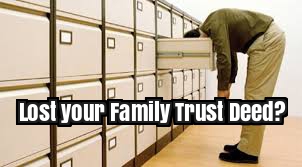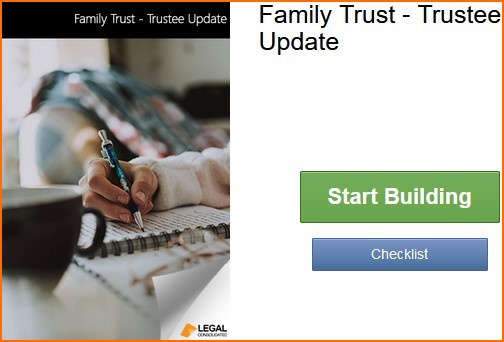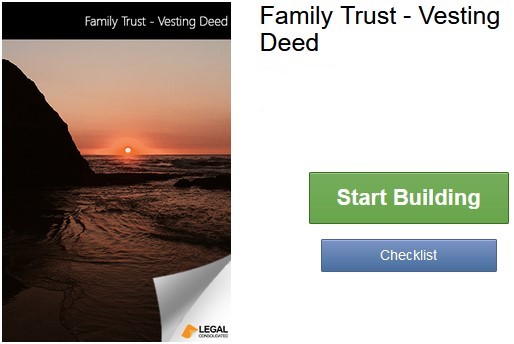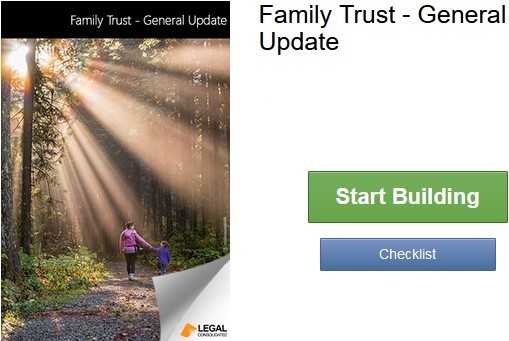Lost Family Trust Deed – can I replace it?
Is a lost family trust deed a bad situation? What is worse?- losing your property Title Deeds;
 losing your Company Constitution, or
losing your Company Constitution, or- losing your family trust Deed

What the Courts say about lost family trust deeds
Consider Sutton v NRS(J) Pty Ltd [2020] NSWSC 826. It demonstrates how important it is to have the: • original signed copies of the Family Trust Deed that set up the Family Trust; and • all subsequent Family Trust updates.Neil loses his Family Trust deed in Sutton v NRS
The facts of Sutton v NRS(J) Pty Ltd are:- On 17 August 1972, a family trust (Trust) is established for the benefit of the family of the plaintiff, Neil Sutton (Neil).
- Strangely the trust was established with a settled sum of $100. (It is usually $10.) And then, more strangely, nothing happens for 30 years.
- In 2007 Neil suddenly starts to use the Family Trust. He purchases properties and businesses under the Family Trust name.
- Neil and his adviser take a photocopy of the original signed Family Trust deed.
- Sadly the original Family Trust deed goes missing.
- Thanks to the latest fad of banks wanting to “know your customer” the bank demands to see the original Family Trust deed.
- Neil pleads with the bank. But to no available. The bank freezes the Family Trust’s bank account.
- The bank will not release the bank account monies until it cites the original Family Trust Deed.
- Desperate Neil goes back to the law firm that originally prepared the Family Trust deed. The law firm produces a safe custody packet with documents. One document is a photocopy of the Trust deed. It is identical to the copy Neil already has.
- Neil now races to the Court seeking an order that the copy is now to be the original Trust deed.
The Court gives Neil a lesson in Latin in Sutton v NRS
Neil argues that a ‘presumption of regularity’ applies under Re Thomson [2015] VSC 370. Re Thomson is about replacing an SMSF deed (rather than the more problematic loss of a Family Trust deed.) Consider Harris v Knight (1890) 15 PD 170, 179–80, Lindley LJ explains the presumption: The maxim is Omnia praesumuntur rite esse acta.- As a Professor in tax law, I interpret the Latin as reasonable probability, and of the propriety in point of law of acting on such probability.
- Or, in other words, an inference is reasonably drawn. This is when an intention to do some formal act is established. And the evidence is consistent with that intention having been carried in effect in a proper way.
- This is where the actual observance of all due formalities can only be inferred as a matter of probability.
“In Re Thomson, the missing trust deed was evidenced only by an unsigned copy, but in the present case, there is no particular need to prove by inference that any formality has been complied with. The photocopy Trust Deed is signed and the evidence establishes directly that the parties concerned have always acted on the basis that it sets out the terms of the Presumed Trust.
In my opinion, the evidence makes it overwhelmingly likely that the photocopy Trust Deed is indeed a copy of an original which now cannot be found. This conclusion is supported in particular, by the recent discovery of an identical copy of the Trust Deed in the records of Clayton Utz dated from 1972.
In these circumstances, the Court should assist those responsible for the administration of the presumed trust by ensuring that they can continue to administer it as if the photocopied Trust Deed were the trust’s constituting document.”
- The Court wanted to help Neil. It believed in his cause. The Court considered that there were two difficulties in providing declaratory relief as follows:
- The Court noted that declarations are used to determine formally a legal state of affairs. They are not to determine a mere matter of fact.
- Thus, as an alternative to the declaratory relief sought by Neil, the Court exercised its advice power under s 63 of the Trustee Act 1925 (NSW), to provide advice as follows:
- The trustees of the trust settled by Frederick Walter Sutton by Deed of Trust dated 23 October 1972 are justified in administering the trust on the basis that the document annexed to this order and marked “A” is a true copy of that Deed.
Court replacing a Family Trust Deed from an unsigned copy – Richardson Pty Limited [2021]
What if you have an unsigned copy of the Family Trust Deed? It was probably never signed. See The application of M & L Richardson Pty Limited [2021] NSWSC 105. It shows where a court may make an order. This is for a trust to be administered from just a copy of the unsigned family trust deed. This is where the original family trust deed may never have been signed. This case is an application for judicial advice. This is under section 63 Trustee Act 1925 (NSW). It is brought by M & L Richardson Pty Limited. This company is the corporate trustee of the M & L Family Trust. The problem posed is a familiar one. The Trust is administered for a number of years. This is under the terms of an unsigned family trust deed. During the 80-year life of the Family Trust often there is the need to show the original signed trust deed to a bank or the ATO. But no one concerned with the administration of the Trust could find the M & L Family Trust Deed. The trustee seeks advice. Is it justified to administer the Family Trust using the unsigned copy of the Family Trust deed? This type of problem is considered in a series of decisions starting with:- McLelland J, in Maks v Maks (1986) 6 NSWLR 34
- Re Porlock Pty Limited [2015] NSWSC 1243 (Young AJA)
- Barp Nominees Pty Limited [2016] NSWSC 990 (Pembroke J)
- Application of Brailey Holdings Pty Limited ACN 001 190 441 [2018] NSWSC 1493
- evidence that the unexecuted (or lost executed) family trust deed actually existed to constitute the Trust. This is so that there is no question under the Statute of Frauds.
- is that there is secondary evidence of the terms of the unsigned family trust deed.
The decision of The application of M & L Richardson Pty Ltd
I enjoy the judgments from Kunc J. And Kunc J serves to provide another excellent education. Kunc J eloquently states:“In so far as the existence of an original signed trust deed is concerned, the Court has evidence from the service provider which originally arranged for the settlement of the Trust (Australian Company Incorporations Services Pty Limited (ACIS)) that it did indeed establish such a trust in accordance with the unexecuted copy in evidence.
Furthermore, there is evidence that the Trust has operated a bank account for many years. There is evidence from the bank of a matter of which I would have been prepared to take judicial notice in any event, which is that the bank would not have allowed a bank account to be opened without having seen at least a copy of the executed trust deed. Unfortunately, the bank has been unable to locate a copy of such a document in its records.
These matters and other points of detail set out in the thorough evidence which has been provided provide clear and convincing proof that the Trust had been settled in accordance with the unexecuted copy in evidence. There is also extensive evidence of the searches and inquiries that have been made, including through the now three firms of accountants who have acted for the Trust, for the original executed trust deed. All of those searches have been unsuccessful.
Nevertheless, that evidence also makes clear that since about 2009, when the Trust was established, it has been administered in accordance with an unexecuted copy of the trust deed.
Continuous administration of the Trust in accordance with an identified unexecuted copy of the trust deed is also sufficient to provide clear and convincing proof of the second element, which is the terms of the Trust. I am fortified in that conclusion because, as part of the inquiries that have been made, ACIS has provided from its records what it says is a copy of the original trust deed, albeit unsigned. The evidence is that they do not retain copies of the signed trust deed, but do retain an unexecuted copy of the trust deed as part of their records.
For these reasons, the Court finds both that the Trust was established in or about 2009 by an executed trust deed and that the terms of the Trust are set out in the unexecuted copy of the trust deed which appears under tab C, pages 13-53 in Exhibit MR1 to the affidavit of Matthew Richardson of 17 September 2020 (being the unexecuted copy of the trust deed provided by ACIS).”
Other Court cases on lost family trust deeds;
- Totos Family Trust [2018] VSC 398
- Barp Nominees Pty Ltd [2016] NSWSC 990
“The trustee would be justified in … managing and administering a trust in accordance with a reconstructed deed”
- Re Thomson [2015] VSC 370. The presumption of regularity helped in this case.
A 1976 Family Trust deed – everything is unwound
Mantovani v Vanta Pty Ltd
Facts of Mantovani v Vanta
Teresa is the power behind the Mantovani clan. She has four beautiful children. They are in their 60s. (You can be in your 60s and be beautiful.)- A Family Trust was created in 1976.
- The corporate trustee is Vanta Pty Ltd.
- While you would never do it now, the settlor is Teresa’s dad.
- The Family Trust Deed can not be found.
- There is a schedule. But nothing else.
- No one denies that Vanta Pty Ltd is the trustee and owns the real estate as trustee for the family trust.
Giovanni is one of Teresa’s children. Giovanni lives in one of the family trust’s properties. This is for his entire life.
Giovanni claims it is his house. He spent money on the property. He maintained the property. He gave the property love, as you do when it is your home. He claims that mum promised the home to him when she died. This is called equitable estoppel. But:- While the Appointor controls the Family Trust, we do not know who the Appointor is, as the Family Trust deed is lost
- We need to look at who controls the corporate trustee of the Family Trust.
- Giovanni is not a director of Vanta Pty Ltd.
- Instead, two of Giovanni’s siblings are directors. They are Nicola and Salvatore.
- the home belongs to the trust, not the lazy brother
- Giovanni is not even a beneficiary of the Family Trust
- the property has nothing to do with Mum’s estate
Decision of Mantovani v Vanta
Everyone accepts these facts:- The Family Trust was created
- The Family Trust Deed can not be found
- The Family Trust schedule is genuine
- Financial statements and income tax returns are prepared each year. And provide evidence of what the deed’s contents may have been.
- that the Family Trust could only continue to exist on ‘mere guesswork’.
- the Family Trust’s deed contains the rules, but it cannot be worked out.
- the trustee cannot, therefore, discharge its obligation. It cannot follow the rules of the trusts. As the rules are lost.
- accordingly, the Family Trust fails.
- as Teresa put the bulk of the assets into the Family Trust the assets go into Mum’s estate.
Legal Consolidated’s comments on Mantovani v Vanta
Reading between the lines the result may have been different if the Trustee of the Family Trust had of quietly applied for court orders. This is rather than waiting for an angry child to wreak havoc.Northgate Park v Floyd [2022] VSC 783 – a less strict approach Lost Deed Case – Lawyer Provides Expert Evidence on Likely Terms of Missing Trust Deed
Facts of Northgate Park
The case of Northgate Park v Floyd [2022] VSC 783 (Northgate Park) presents an intriguing development in how courts may approach the issue of a lost trust deed. Northgate Park represents a less strict approach to determining the terms of a trust when a deed is lost. The Norgate Park trust deed went missing and the Victorian Supreme Court was tasked with what to do. Question: Did the ‘trust’ ever exist? If so, under what terms (if any could be proven) the trustee was obligated to perform its role as trustee of the Trust, or whether the Trust instead failed due to uncertainty? The court accepted evidence that the Trust was established in 1991 and had continued to operate since that time. This 1991 establishment deed (1991 Deed) was lost. While searches had been conducted for the 1991 Deed previously, it had not been found. In 2015, two further ‘replacement trust deeds’ (2015 Deeds) were signed to replace the 1991 Deed. The 2015 Deeds acknowledged that the 1991 Deed was lost and agreed on the terms and key roles of the Trust, such as the trustee and appointors.Can Expert Evidence be used for lost trust deeds?
Independent expert evidence was provided by a lawyer with extensive experience in drafting discretionary trust deeds. This evidence focused on:- The usual process for preparing trust deeds.
- The typical beneficiaries of the trust.
- The usual individuals holding key roles as trustee and appointor.
- The customary terms included in trust deeds from that period, including the likely content of the variation power.
Conclusion of Norgate Park
While other litigation was raging, the parties to Northgate Park agreed on the adoption of the expert evidence and ultimately the agreed terms of the Trust. This case emphasises that the courts are willing to adopt an approach where those involved in the trust agree on how the trust will continue. This case also illustrates that even when no document exists, a court may be willing to accept evidence as to the likely terms of a trust based on expert evidence of the usual approach to drafting at the relevant time the trust was established. This and other recent lost trust deed cases show that courts generally prefer an outcome where a trust can continue. A trustee’s first duty is to administer the trust per the terms of the trust. Naturally, this requires that the trustee can read and know the terms of the trust. However, many trustees find that they cannot produce all documents forming the document trail of their trust, and thus they cannot prove they are complying with this basic duty. This is a nightmare for the accountant who needs to build the Trust Distribution Minutes of Legal Consolidate’s website. While other options may be open to a trustee, it is often appropriate to seek judicial guidance or a declaration as to the terms of their trust. Failure to deal with these issues can result in a trustee being removed by a court, and another person appointed in their place. Thus, prudent trustees should seek to deal with these issues directly, as ignoring them could cause them to lose control of the trust.Four approaches for lost family trust deeds:
1. Lost Family Trust deed with no assets
If the Family Trust has no asset then merely wind it up here. If the trust has assets with little value, then build a new Family Trust and transfer the assets into the new Family Trust – you pay stamp duty and Capital Gains Tax on the transfer from one trust to another. This is a ‘resettlement’. For CGT, the trust is treated as having ‘sold’ the assets of the old Family Trust to the ‘new’ Family Trust for market value. However, this is not an issue if you are just holding cash. Each State has a Trust Act. However, it just ends up causing more problems. For example, there is a duty to act fairly between income and capital beneficiaries and avoid conflicts and restricted powers to sell trust property. This is exactly what you don’t want in a Family Trust.2. Find the original Trust Deed (or even a copy)
Hunt down the original Trust Deed. Consider these options:
- Ex-spouse, parents and children, and their accountants
- Current and former accountants, financial planners, auditors, and law firms
- Beneficiaries that may have required a copy of the Trust Deed
- Centrelink if you ever needed to provide it with a copy
- Australian Tax Office if you ever needed to provide it with a copy
- Banks (they normally certify a full copy for their records)
- Bank vaults (including those operated by your parents, children, ex-spouse or mistress)
- Old tax returns and where you hold valuable documents
3. Get a Court Order to replace a lost Family Trust deed
Australia our law firm seeks a Court Order stating that a ‘replacement’ Deed is the ‘old’ Deed. The ATO is bound by this. There is no resettlement and you suffer no stamp duty or triggering of Capital Gains Tax. While expensive, it fixes everything. The evidence required for the Court proceedings often includes:- that the Trust Deed was correctly established (eg. Tax File Number application)
- the terms of the lost trust deed (eg. Financials and distribution statements)
- the assets in the trust fund (eg. old Balance sheets)
- the searches you have undertaken
4. Get an ATO Private Ruling and seek an exemption from the Stamp Duty Office
We create a new Family Trust Deed and then approach the ATO and Stamp Duty Office to confirm that there is no resettlement. The Deed of Variation is subject to and conditional upon successful sign-off by both the ATO and the local transfer duty officer. There is no risk, but potentially no reward either.The Family Trust deed was never lost – it just never existed
In Re Lauer [2017] VSC 728 the dead person’s Will left everything to a yet-to-be-formed ‘family trust’. The Family Trust was to be named the Elizabeth Lauer Family Trust. (Yes, I know that is a silly thing to do – 3-Generation Testamentary Trusts are better. And it gets worse.) Elizabeth decides to save money. She does not speak with her accountant. She shuns the financial planners. She avoids the taxation lawyer. Instead, her friend copies and amends an old family trust deed. The friend has five goes at it. Eventually the Court, in despair, declares there to be no trust.| Build these Trust Deeds online | |
|---|---|
Family Trust |
|
| Family Trust Deed – over 18,000 sold | |
| Family Trust Updates: | |
| 1. Everything – Deed, Appointor and Trustee (recommended) – includes succession planning | |
| 2. Upgrade the Family Trust Deed only – streaming, Bamford, trust law & tax | |
| 3. Change the Appointor – includes succession planning | |
| 4. Replace the trustee only | |
| 5. Change Name of the Family Trust | |
| 6. Exclude a Beneficiary in the Family Trust | |
| Company – Trustee of a Family Trust – corporate trustee for asset protection & business | |
| Company – Bucket Company – beneficiary of a Family Trust | |
| Annual Distribution Minutes for Family Trust – sign minutes before 30 June – ring us if building over 10 | |
| Forgive Family Trusts’ UPEs – human forgives money the Family Trust owes (UPEs & loans) | |
| Deed of Gift – to prove the money you put into your Family Trust was a gift (not a loan) | |
| Division 7A Loan Deed – company lends trust money to Family Trust (UPEs & loans) | |
| Loan Agreement – lend money to your Family Trust | |
| Vesting Deed – wind up your old Family Trust (Centrelink compliant) | |
| Training Course on Family Trusts – includes the Family Trust Deed |

